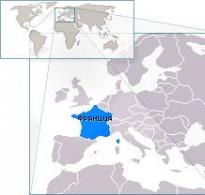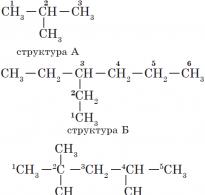Two geometric figures are called equal if they can be combined. Equal figures are What two figures are called equal
Plane figures with the same areas or geometric bodies with the same volumes ... Big Encyclopedic Dictionary
Plane figures with the same areas or a geometric body with the same volumes. * * * EQUAL-VALUE FIGURES EQUAL-VALUE FIGURES, flat figures with the same areas or geometric bodies with the same volumes ... encyclopedic Dictionary
Plane figures with the same area or geome. bodies with the same volume... Natural science. encyclopedic Dictionary
Equal-sized figures are flat (spatial) figures of the same area (volume); equally composed figures of a figure that can be cut into the same number of respectively congruent (equal) parts. Usually the concept... Great Soviet Encyclopedia
Two figures in R2 having equal areas and, respectively, two polygons M1 and M 2 such that they can be cut into polygons so that the parts that make up M 1 are respectively congruent to the parts that make up M 2. For, equal area ... ... Mathematical Encyclopedia
EQUAL, oh, oh; ik. 1. Equal in strength, capabilities, value (book). Equivalent phenomena. 2. equal-sized figures (bodies) in mathematics: figures (bodies) that are equal in area or volume. | noun equivalence, and, wives. Ozhegov's explanatory dictionary. ... ... Explanatory dictionary of Ozhegov
Here are collected definitions of terms from planimetry. References to terms in this dictionary (on this page) are in italics. # A B C D E F F G I K L M N O P R S ... Wikipedia
Here are collected definitions of terms from planimetry. References to terms in this dictionary (on this page) are in italics. # A B C D E F G I J K L M N O P R S T U V ... Wikipedia
Shapes that match when superimposed are called EQUAL. Two geometric figures are called equal if they can be combined when superimposed
9. Explain how to compare two line segments and how to compare 2 angles. You superimpose one segment on the other so that the end of the first is aligned with the end of the second, if the other two ends are not aligned, then the segments are not equal, if they are aligned, then they are equal. To compare 2 segments, you need to compare their lengths; to compare 2 angles, you need to compare their degree measure. Two angles are called equal if they can be combined by overlapping. To establish whether two non-expanded angles are equal or not, it is necessary to combine the side of one angle with the side of the second so that the other two sides are on the same side of the combined sides.Lay one corner on the other corner in such a way that their vertices coincide on one side, and the other two are on the same side of the aligned sides. If the second side of one angle is aligned with the second side of another angle, then these angles are equal. (Simpose the corners so that the side of one is aligned with the side of the other, and the other two are on the same side of the aligned sides. If the two other sides are aligned, then the angles are completely aligned, which means they are equal.)
10. What point is called the midpoint of the segment? The midpoint of a segment is the point that divides the given segment into two equal parts. The point that divides a segment in half is called the midpoint of the segment.
11. Bisector(from Latin bi- “double” and sectio “cutting”) an angle is called a ray emerging from the top of the angle and passing through its inner region, which forms two equal angles with its sides. Or a ray emanating from the vertex of an angle and dividing it into two equal angles is called angle bisector.
12. How is the measurement of segments. To measure a segment commensurate with one means to find out how many times it contains a unit or some fraction of a unit. Distance measurement is carried out by comparing it with a certain segment taken as a unit. You can measure the length of the segment using a ruler or measuring tape. It is necessary to superimpose one segment on another, which we have taken as a unit of measurement, so that their ends are aligned.
? 13. How are the lengths of segments AB and CD related if: a) segments AB and CD are equal; b) is segment AB less than segment CD?
A) the lengths of segments AB and CD are equal. B) the length of the segment AB is less than the length of the segment CD.
14. Point C divides segment AB into two segments. How are the lengths of segments AB, AC and CB related? The length of the segment AB is equal to the sum of the lengths of the segments AC and CB. To find the length of segment AB, add the lengths of segments AC and CB.
15. What is a degree? What does the degree measure of an angle show? Angles are measured in different units. It can be degrees, radians. Most often, angles are measured in degrees. (This degree should not be confused with a measure of temperature, where the word "degree" is also used). The measurement of angles is based on comparing them with an angle taken as a unit of measurement. Usually, a degree is taken as a unit of measurement for angles - an angle equal to 1/180 of a developed angle. Degree is a unit of plane angles in geometry. (The degree is taken as the unit of measurement of geometric angles - part of the angle.) .
Degree measure of an angle shows how many times a degree and its parts - a minute and a second - fit into a given angle , that is, a degree measure - a value that reflects the number of degrees, minutes and seconds between the sides of the angle.
16. What part of a degree is called a minute, and what part is called a second? 1/60 of a degree is called a minute, and 1/60 of a minute is called a second. Minutes are denoted by the sign "′", and seconds - by the sign "″"
? 17. How are the degree measures of two angles related if: a) these angles are equal; b) one angle is less than the other? a) the degree measure of the angles is the same. b) The degree measure of one angle is less than the degree measure of the second angle.
18. Ray OC divides angle AOB into two angles. How are the degree measures of the angles AOB, AOC and COB related? When a ray divides an angle into two angles, the degree measure of the entire angle is equal to the sum of the degree measures of those angles. Degree measure of an angle AOB is equal to the sum of the degree measures of its parts AOC and COB.
“A cylinder is called a body” - A section of a cylinder by a plane passing through the axis of the cylinder is called an axial section. A cylinder, an axial section whose square is called equilateral. Project "Mathematics in the profession "Cook, confectioner". Task number 3. Cylinders. The height of a cylinder is the distance between the planes of the bases. The height of the cylinder is 8 m, the radius of the base is 5 m. The cylinder is crossed by a plane so that the cross section is a square.
"Areas of figures geometry" - Equal figures have equal areas. in). what will be the area of the figure composed of figures A and D. The figures are divided into squares with a side of 1 cm. Equal figures b). The area of a parallelogram. Figures with equal areas are called equal areas. Areas of various figures. Area units. Area of a triangle.
"Areas of figures" - The area of a triangle. The area of a plane figure is a non-negative number. Let S be the area of triangle ABC. Solution: Theorem: Area of a parallelogram. Solution. The area of a square with side 1 is equal to 1. Problem. Cutting and folding. Equal polygons have equal areas. Fourth property: The theorem is proved.
"Construction of geometric figures" - Methods of image and construction of spatial figures on a plane. Buildings on the projection drawing. P4: Construct (find) the point of intersection of the given line and circle. Requirements - the desired figure (set of figures) with the specified properties. algebraic method. Stages of solving construction problems.
"Geometric progression" - 1073741823 > 3000000, so the merchant lost! Geometric progression. The infinite sum turned out to be equal to a completely finite value - the height of the triangle. Property of a geometric progression: Problem solution: b1 = 1, q =2, n =30. Bn = b1 · qn – 1 is the formula of the nth member of the progression. The formula for the sum of an infinite decreasing geometric progression:
"Likeness of figures" - Plants. Geometry. Similarity surrounds us. Toys. similarity in our lives. Here are some examples from our life. If you change (increase or decrease) all dimensions of a flat figure by the same number of times (similarity ratio), then the old and new figures are called similar. Internet materials were used.
What figures are called equal?
Shapes are called equal, which match when superimposed.
A common mistake to this question is the answer, which mentions the equal sides and angles of a geometric figure. However, this does not take into account that the sides of a geometric figure are not necessarily straight. Therefore, only the coincidence of geometric figures when superimposed can be a sign of their equality.
In practice, this is easy to check using the overlay, they must match.
Everything is very simple and accessible, usually equal figures can be seen immediately.
Equal are those figures that have the same geometry parameters. These parameters are: the length of the sides, the size of the angles, the thickness.
The easiest way to understand that the figures are equal is by using an overlay. If the sizes of the figures are the same, they are called equal.
Equal name only those geometric shapes that have exactly the same parameters:
1) perimeter;
2) area;
4) dimensions.
That is, if one figure is superimposed on another, then they will coincide.
It is a mistake to assume that if the figures have the same perimeter or area, then they are equal. In fact, geometric figures that have the same area are called equal.
Figures are called equal if they coincide when superimposed on each other. Equal figures have the same size, shape, area and perimeter. But figures that are equal in area may not be equal to each other.
In geometry, according to the rules, equal figures must have the same area and perimeter, that is, they must have absolutely the same shape and size. And they must match exactly when they are superimposed on each other. If there are any discrepancies, then these figures can no longer be called equal.
Figures can be called equal provided that they completely coincide when superimposed on each other, i.e. they have the same size, shape and therefore area and perimeter, as well as other characteristics. Otherwise, it is impossible to talk about the equality of the figures.
The very word equal contains the essence.
These are figures that are completely identical to each other. That is, they completely match. If the figure is put one on one then the figures will overlap themselves from all sides.
They are the same, that is, they are equal.
Unlike equal triangles (to determine which it is enough to fulfill one of the conditions - signs of equality), equal figures are called those that have the same not only shape, but also dimensions.
To determine whether one figure is equal to another, you can use the overlay method. In this case, the figures must match both sides and corners. These will be equal figures.
Only such figures can be equal, which, when superimposed, completely coincide with the sides and corners. In fact, for all the simplest polygons, the equality of their area also indicates the equality of the figures themselves. Example: a square with side a will always be equal to another square with the same side a. The same applies to rectangles and rhombuses - if their sides are equal to the sides of another rectangle, they are equal. A more complex example: triangles will be congruent if they have equal sides and corresponding angles. But these are only special cases. In more general cases, the equality of the figures is nevertheless proved by superposition, and this superposition in planimetry is pompously called movement.
the middle of the segment?
Which ray is called the angle bisector?
what is the degree measure of an angle?
What figure is called a triangle? What triangles are called equal? Which segment is called the median of a triangle? Which segment is calledthe bisector of a triangle? Which segment is called the height of a triangle? Which triangle is called isosceles? Which triangle is called equilateral? Definition of radius, diameter, chord. Give a definition of parallel lines. What angle is called the external angle of a triangle? Which triangle is called acute-angled, which triangle is called obtuse-angled, which right-angled. What are the sides of a right triangle called? Property of two lines parallel to a third. Theorem on a line intersecting one of the parallel lines. Property of two lines perpendicular to a third
What shape is called a broken line? What are vertex links and polyline length?Explain what a broken line is called a polygon. What are the vertices, sides, perimeter and diagonals of a polygon? What is a convex polygon?
Explain what angles are called convex angles of a polygon. Derive a formula for calculating the sum of the angles of a convex n-gon. Prove that the sum of the exterior angles of a convex polygon. TAKEN one at each vertex, equals 360 degrees.
What is the sum of the angles of a convex quadrilateral?
2) What are vertices, angles, sides, diagonals, perimeter of a quadrilateral?
3) What side angles of a quadrilateral are called convex?
4) what is the sum of the angles of a convex quadrilateral?
5) what quadrilateral is called convex?
6) what quadrilateral is called a parallelogram?
7) what properties does a parallelogram have?
8) name the signs of a parallelogram.
9) formulate the properties of a rectangle.
10) what quadrilateral is called a square?
11) formulate the properties of a rhombus.
12) what quadrilateral is called a rhombus?
13) what quadrilateral is called a rectangle?
14) what properties does a square have? please answer briefly...
called a triangle.
2. What is the perimeter of a triangle?
3. What triangles are called equal?
4. What is a theorem and proof of a theorem?
5. Explain which segment is called a perpendicular drawn from a given point to a given line.
6. Which segment is called the median of the triangle? How many medians does a triangle have?
7. Which segment is called the bisector of a triangle? How many bisectors does a triangle have?
8. What segment is called the height of the triangle? How many heights does a triangle have?
9. What triangle is called isosceles?
10. What are the names of the sides of an isosceles triangle?
11. What triangle is called an equilateral triangle?
12. Formulate the property of angles at the base of an isosceles triangle.
13. Formulate a theorem on the bisector of an isosceles triangle.
14. Formulate the first sign of equality of triangles.
15. Formulate the second sign of equality of triangles.
16. Formulate the third criterion for the equality of triangles.
17. Define a circle.
18. What is the center of a circle?
19. What is called the radius of a circle?
20. What is called the diameter of a circle?
21. What is called the chord of a circle?





